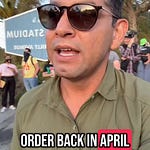From the emptied lunch streets of Vernon to the shuttered fruteros outside LA’s hospitals, fear is becoming the city’s most powerful economic force. I report on what it means when entire communities go quiet — not out of protest, but out of self-preservation.
By Nick Valencia
LOS ANGELES — The birds in my neighborhood sound louder lately.
That’s not poetic — it’s practical. The usual soundtrack of city life has been replaced by something quieter. Not because people have left. Because they’re staying in.
On paper, Los Angeles is still open for business. But in pockets of this county, especially where immigrant Latino labor is the backbone of the local economy, fear has become the new policy. Not fear of inflation or recession — fear of being seen. Fear of being taken.
Across the Southland, neighborhoods are experiencing what feels like a soft lockdown. People are disappearing from public life just the same. And it’s not by choice. It’s out of survival.
I’ve grew up in this city and have kept coming back long enough to recognize when something’s off. It’s not just that traffic is lighter. It’s the corner panadería that’s suddenly closed on a weekday. It’s the empty aisles at the discount mercado around the corner of my house on Figueroa. And it’s the quiet, anxious pause before someone answers my questions, if they answer at all.
This isn’t theoretical. It’s not a policy debate. It’s a lived one.
Immigration enforcement doesn’t just target the undocumented — it affects entire communities. Mixed-status families, Latino business owners, day laborers, nannies, gardeners, construction crews. When ICE ramps up its visibility, or even when rumors of raids circulate, the result is a contraction. A pullback. Not just in spirit, but in dollars.
And that has real economic consequences.
According to a 2019 report by the UCLA Latino Policy and Politics Institute, undocumented immigrants in California contribute an estimated $3 billion annually in state and local taxes. The majority of them work in industries where labor can’t be done remotely: agriculture, hospitality, construction, domestic work. When they vanish from the workforce — whether due to fear or enforcement — the ripple effect isn’t just felt at home. It’s felt in payrolls, in storefronts, and in neighborhoods that run on daily hustle.
We’ve seen this pattern before.
In the wake of Arizona’s SB 1070 — the “show me your papers” law — economists documented a steep drop in consumer spending and local tax revenues in immigrant-heavy communities. When people feel hunted, they don’t just go into hiding. They stop engaging with the economy altogether.
And while Los Angeles hasn’t passed anything close to SB 1070, the fear here today feels just as potent. ICE doesn’t need to sweep through a neighborhood for people to start disappearing. Word of mouth is enough. A viral video. A false alarm. A credible rumor. And just like that, the wheels stop turning.
On Thursday, I was in the city of Vernon during the lunch hour. Normally, it’s buzzing — streets packed with workers spilling out of industrial buildings, grabbing tacos, fruit cups, and papusas from the sidewalk vendors who’ve fed this city for decades. But that day, it was empty. The fruteros were gone. The foot traffic — vanished.
About an hour after I left, I got a message from someone on social media: ICE had picked up a fruit vendor just outside the Keck Hospital, only a few miles away. The fear I had just witnessed in Vernon wasn’t abstract. It was real — and close.
Now, across social media, videos are surfacing of deserted vendor stalls. Once bustling tables now sit folded and vacant. Not-so-subtle symbols of the climate on the streets of the Southland. Not a crackdown in name — but in effect.
This is what fear looks like. And it’s changing the economy in ways no GDP report will ever capture.








Share this post